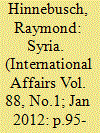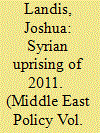| Srl | Item |
| 1 |
ID:
137842


|
|
|
|
|
| Summary/Abstract |
For decades, Iran has supported the regime of Bashar al-Asad in Syria with military advisors, weapons, and both diplomatic and financial support due to Tehran's belief that a pro-Iranian government in Syria is a core national interest. In this regard, cooperation with Damascus has provided Tehran with a number of strategic advantages, which it is loath to surrender. More recently, the Iranians have also come to view Syria as a vital ally against the threat of the Islamic State in Iraq and al-Sham (ISIS). In this environment, the Islamic Republic will likely continue to bolster the Asad regime even if the Syrian civil war continues for years.
|
|
|
|
|
|
|
|
|
|
|
|
|
|
|
|
| 2 |
ID:
111692


|
|
|
|
|
| Publication |
2012.
|
| Summary/Abstract |
Syria was, until recently, seen as a 'successful' example of authoritarian 'upgrading' or 'modernization;' yet in 2011 the Syrian regime faced revolution from below: what went wrong? Bashar al-Asad inherited a flawed regime yet managed to start the integration of his country into the world capitalist market, without forfeiting the nationalist card by, for instance, attempting to acquire legitimacy from opposition to Israel and the US invasion of Iraq. Yet, despite his expectations and that of most analysts, his regime proved susceptible to the Arab uprising. This article examines the causes and development of the Syrian uprising of 2011. It contextualizes the revolt by showing how the construction of the regime built in vulnerabilities requiring constant 'upgradings' that produced a more durable regime but had long term costs. It focuses on Bashar al-Asad's struggles to 'modernize' authoritarianism by consolidating his own 'reformist' faction, balancing between the regime's nationalist legitimacy and its need for incorporation into the world economy; his shifting of the regime's social base to a new class of crony capitalists; and his effort to manage participatory pressures through limited liberalization and 'divide and rule'. The seeds of the uprising are located in these changes, notably the abandonment of the regime's rural constituency and debilitating of its institutions. Yet, it was Asad's inadequate response to legitimate grievances and excessive repression that turned demands for reform into attempted revolution. The article then analyses the uprising, looking at the contrary social bases and strategies of regime and opposition, and the dynamics by which violence and foreign intervention have escalated, before finishing with comments on the likely prognosis.
|
|
|
|
|
|
|
|
|
|
|
|
|
|
|
|
| 3 |
ID:
112116


|
|
|